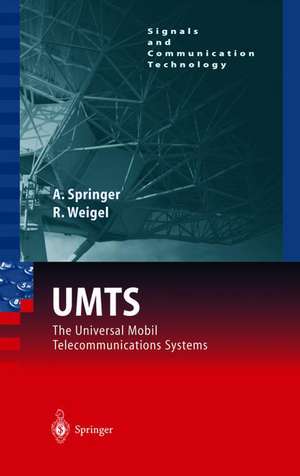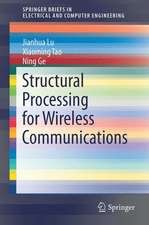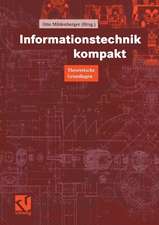UMTS: The Physical Layer of the Universal Mobile Telecommunications System: Signals and Communication Technology
Autor Andreas Springer, Robert Weigelen Limba Engleză Hardback – 11 iun 2002
| Toate formatele și edițiile | Preț | Express |
|---|---|---|
| Paperback (1) | 781.94 lei 6-8 săpt. | |
| Springer Berlin, Heidelberg – 15 dec 2010 | 781.94 lei 6-8 săpt. | |
| Hardback (1) | 646.30 lei 6-8 săpt. | |
| Springer Berlin, Heidelberg – 11 iun 2002 | 646.30 lei 6-8 săpt. |
Din seria Signals and Communication Technology
- 18%
 Preț: 952.89 lei
Preț: 952.89 lei - 18%
 Preț: 1559.80 lei
Preț: 1559.80 lei - 17%
 Preț: 361.80 lei
Preț: 361.80 lei - 18%
 Preț: 811.61 lei
Preț: 811.61 lei - 15%
 Preț: 585.26 lei
Preț: 585.26 lei - 18%
 Preț: 727.97 lei
Preț: 727.97 lei - 15%
 Preț: 585.90 lei
Preț: 585.90 lei -
 Preț: 393.35 lei
Preț: 393.35 lei - 20%
 Preț: 1002.72 lei
Preț: 1002.72 lei - 15%
 Preț: 641.71 lei
Preț: 641.71 lei - 20%
 Preț: 338.91 lei
Preț: 338.91 lei - 18%
 Preț: 1579.66 lei
Preț: 1579.66 lei - 18%
 Preț: 896.08 lei
Preț: 896.08 lei - 18%
 Preț: 847.11 lei
Preț: 847.11 lei - 18%
 Preț: 1234.77 lei
Preț: 1234.77 lei - 18%
 Preț: 905.54 lei
Preț: 905.54 lei - 15%
 Preț: 646.43 lei
Preț: 646.43 lei - 20%
 Preț: 662.48 lei
Preț: 662.48 lei - 15%
 Preț: 641.20 lei
Preț: 641.20 lei - 18%
 Preț: 1847.84 lei
Preț: 1847.84 lei - 18%
 Preț: 946.24 lei
Preț: 946.24 lei - 18%
 Preț: 1241.10 lei
Preț: 1241.10 lei - 20%
 Preț: 649.43 lei
Preț: 649.43 lei - 20%
 Preț: 993.28 lei
Preț: 993.28 lei - 18%
 Preț: 940.57 lei
Preț: 940.57 lei - 18%
 Preț: 1389.30 lei
Preț: 1389.30 lei - 20%
 Preț: 1003.50 lei
Preț: 1003.50 lei - 18%
 Preț: 953.52 lei
Preț: 953.52 lei - 20%
 Preț: 1001.16 lei
Preț: 1001.16 lei - 18%
 Preț: 1415.36 lei
Preț: 1415.36 lei - 15%
 Preț: 653.33 lei
Preț: 653.33 lei - 15%
 Preț: 645.60 lei
Preț: 645.60 lei - 15%
 Preț: 637.28 lei
Preț: 637.28 lei - 18%
 Preț: 948.79 lei
Preț: 948.79 lei - 18%
 Preț: 945.62 lei
Preț: 945.62 lei - 18%
 Preț: 836.36 lei
Preț: 836.36 lei - 18%
 Preț: 1225.46 lei
Preț: 1225.46 lei - 15%
 Preț: 635.01 lei
Preț: 635.01 lei - 15%
 Preț: 639.25 lei
Preț: 639.25 lei - 15%
 Preț: 639.25 lei
Preț: 639.25 lei - 15%
 Preț: 712.36 lei
Preț: 712.36 lei - 20%
 Preț: 1006.12 lei
Preț: 1006.12 lei - 18%
 Preț: 970.56 lei
Preț: 970.56 lei
Preț: 646.30 lei
Preț vechi: 760.35 lei
-15% Nou
Puncte Express: 969
Preț estimativ în valută:
123.67€ • 129.12$ • 102.35£
123.67€ • 129.12$ • 102.35£
Carte tipărită la comandă
Livrare economică 04-18 aprilie
Preluare comenzi: 021 569.72.76
Specificații
ISBN-13: 9783540421627
ISBN-10: 3540421629
Pagini: 316
Ilustrații: XIV, 298 p.
Dimensiuni: 156 x 234 x 23 mm
Greutate: 0.58 kg
Ediția:2002
Editura: Springer Berlin, Heidelberg
Colecția Springer
Seria Signals and Communication Technology
Locul publicării:Berlin, Heidelberg, Germany
ISBN-10: 3540421629
Pagini: 316
Ilustrații: XIV, 298 p.
Dimensiuni: 156 x 234 x 23 mm
Greutate: 0.58 kg
Ediția:2002
Editura: Springer Berlin, Heidelberg
Colecția Springer
Seria Signals and Communication Technology
Locul publicării:Berlin, Heidelberg, Germany
Public țintă
Professional/practitionerCuprins
1. Introduction.- 2. Fundamentals.- 3. Spread Spectrum Techniques.- 4. Code Division Multiple Access.- 5. Introduction to UMTS.- 6. UTRA FDD Mode.- 7. UTRA TDD Mode.- 8. UMTS Transceiver Design Issues.- B. QoS Parameters for Bearer Services.- C. UTRA FDD Reference.- C.1 Environmental Conditions.- C.1.1 Temperature.- C.1.2 Voltage.- C.1.3 Vibration.- C.2 Downlink DPDCH Slot Formats.- C.3 Uplink DPDCH Slot Formats.- C.4 Quantization of the Gain Factors.- C.5 Scrambling Code Generation.- C.5.1 Uplink Scrambling Code.- C.5.2 Downlink Scrambling Code Generator Polynomials.- C.6 Synchronization Codes.- C.7 OCNS.- D. UTRA TDD Reference.- D.1 Channelization Code Specific Multiplier.- D.2 Weight Factors.- D.3 Gain Factors.- D.4 Synchronization Codes.- E. List of Acronyms.- References.
Recenzii
From the reviews:
"This book describes the physical layer of UMTS (universal mobile Telecommunication System) … . It compiles in a clear fashion the main technical features of the physical layer standard together with a description of the basics of digital communications and spread spectrum technology on which UMTS relies. … The reader will benefit from the standard description which frees him from studying lots of standardization documents. … Many references are provided for readers interested in in-depth treatments of certain topics." (Comtec, June, 2003)
"This book describes the physical layer of UMTS (universal mobile Telecommunication System) … . It compiles in a clear fashion the main technical features of the physical layer standard together with a description of the basics of digital communications and spread spectrum technology on which UMTS relies. … The reader will benefit from the standard description which frees him from studying lots of standardization documents. … Many references are provided for readers interested in in-depth treatments of certain topics." (Comtec, June, 2003)
Textul de pe ultima copertă
This book describes the physical layer of UMTS (Universal Mobile Telecommunication System) which is one of the five members of the IMT-2000 family of standards. It compiles in a clear fashion the main technical features of the physical layer standard together with a description of the basics of digital communications and spread spectrum technology on which UMTS relies. In addition the test cases specified in the standard are described together with their implications on any practical front-end design. The reader will benefit from the standard description which frees him from studying lots of standardization documents. Additional explanations of the standard and especially the test cases will help to better understand the effects on any front-end system design. Many references are provided for readers interested in in-depth treatments of certain topics.
Caracteristici
One of the first books to describe this new standard that will be launched commercially in 2002 Based on lectures given at a topical international conference UMTS will unify the separate the European and American current standards It is designed for mobile multimedia communications











